I bought these over a year ago as an upgrade to the generation 3 of the Piston earphones. I've been a user since generation 2 and I've loved the line up ever since. This simply feels like another marginal improvement to the series. First things first, Xiaomi are definitely using less and less metal with each generation. However, at this price range especially considering the fact that it is a dual driver these price cuts were bound to happen. As for the sound quality, these sound great. With a good seal, the balance between the bass notes, smooth vocals, and detailed highs play a symphony from a device as light as a feather. Am I an audiophile? No, but I am very picky and my ears are in the sensitive side. Until I gather enough funds for a more expensive pair, i believe these are beautiful sounding piece of gear.
You are using an out of date browser. It may not display this or other websites correctly.
You should upgrade or use an alternative browser.
You should upgrade or use an alternative browser.
Xiaomi Mi Hybrid Earphone In-Ear Headphones Multi-unit Circle Iron Mixed Piston Earphones Silver Color
junhawng
New Head-Fier
afterstory100
New Head-Fier
Pros: never looks cheap, very comfy
Cons: far too muffled, very artificial timre, too bass oriented
there's quite a hype about this product in my country, so i decided to buy it from a trusted source.
Starting from packaging, it's quite simple, maybe even too simple, even piston 2 and 3 has better packaging accompanied with hardcase
the only thing i could found positive in this product is the build and ergonomic, so comfy and light, if this thing sounds good i could wear them for hours... unfortunately they doesn't sound as good as they looks
the bass is far too boomy and too upfront (don't get me wrong, i love bass, but this bass is just too muffled). mid and treble has a very stange timbre that sounds thin, and artificial but somehow rolled off but maintaining it's peak.... as a musician, these things bugged me the most. totally a bad product for me.
if you're looking for bass oriented iem, try basic ie 300 instead, the price range is not really different, but it offers better timbre (still muffled though, but better timbre)
Starting from packaging, it's quite simple, maybe even too simple, even piston 2 and 3 has better packaging accompanied with hardcase
the only thing i could found positive in this product is the build and ergonomic, so comfy and light, if this thing sounds good i could wear them for hours... unfortunately they doesn't sound as good as they looks
the bass is far too boomy and too upfront (don't get me wrong, i love bass, but this bass is just too muffled). mid and treble has a very stange timbre that sounds thin, and artificial but somehow rolled off but maintaining it's peak.... as a musician, these things bugged me the most. totally a bad product for me.
if you're looking for bass oriented iem, try basic ie 300 instead, the price range is not really different, but it offers better timbre (still muffled though, but better timbre)
Lup4z
New Head-Fier
Pros: Very good clarity and soundstage, Treat for V-sig people, Ergonomic and comfortable, Easy to drive
Cons: Cord's a bit more delicate as compared to the 3rd Gen Pistons, Slight piece to piece variation, Drivers not streamlined
Alright... So, before I begin with the actual review, there were two earphones that I had the opportunity to listen to. The cord of the first one was rather delicate, got pinched near the jack and got a loose connection. The second one seems a bit sturdier. And now off to the review.
I became an instant fan of Mi IEMs since I bought the Piston 2.0 after seeing it in the WS section of @|joker|'s list (So, many thanks for that man). When the Piston 3.0 came out, I opted to buy it at a higher price (import) cuz I was too eager to wait for it to launch in India and it was still worth it. Fortunately, I didn't have to wait much for the Hybrids and bought it right off the official site.
Unboxing: As usual, I don't have the pics, sorry. Packaging for the Hybrids was a bit disappointing considering the cool, minimalistic box and silicone padding the last two versions came in. This one came in a cardboard box. Plain white, with the Mi logo in the front bottom-center, along with what felt like some kind of gelatin revealing the CD pattern of the IEMs and the remote. Details are listed in tiny gray Chinese characters on the back, with the 1MORE DESIGN logo on the bottom right. The seal for the box is like a paper version of gum wrappers. Catch hold of the strip and pull to tear open. A sub-compartment holding the IEMs slides out. The cord is folded and constricted with translucent/foggy tape. Another compartment in the box contains tips for smaller and larger size.
Built: The Mi In-Ear Headphones Pro carry the same characteristic CD pattern on the back. This time, (like the Pistons 2.0) the housing is metal again, but much lighter than the Pistons 2.0. The rest of the housing is smooth. The nozzle side is plastic. The metal housing has "HD audio" printed on its rim and shows a pretty big, capsule shaped rear vent. The plastic, nozzle side has the R/L inscribed to distinguish the direction and a tiny front vent. The nozzles are smaller than both, the Pistons 2.0 and 3.0. The mesh is pretty much the same albeit smaller. The 3 button controller on the right-side earphone cord carries the same CD-pattern. The middle and volume-down buttons have a notch on the top edge solving the button distinction problem plaguing the previous Piston 3.0. The left and right cords unite at a rubber-like piece with the company logo and continue as a single braided wire ending in a gold-plated 3.5mm jack with a metal shell with the same CD-pattern. No QR-coded plastic tab on the braided cord this time. The first pair that I bought had a much thinner cord, which was easily damaged. The replacement seems significantly stronger.
Comfort & Isolation: The nozzles are angled for an ergonomic design. The plastic that connects the metal housing to the cord can sometimes get in the way of a perfect fit. But overall the IEMs are very comfortable. Noise conducted by movement of the cord is a bit lesser than Piston 3.0, but still quite significant. IMO the Pistons 2.0 had the least knocking among the three (probably because of the rubber/silicon shield?). Isolation is quite low but that was expected as soon as I saw the size of the rear vent in the online pics. Not a deal breaker for me, personally.
Service: For any accessory servicing, you need all the components of the product (box, invoice, tips, etc.). If you have these, replacement is a breeze. They gave a free replacement date of about a month but they take barely a week or so (free only if submitted within the 6-month warranty period).
SQ:
Note: All observations done on Feel the Wind (JetEffect EQ) which is the default EQ on my Cowon i10. Tracks ranged from Aryeh Frankfurter (Celtic Harp), Yiruma - A river Flows in You, Afghan Jalebi (I know, I know...) and Ace of Spades and such.
Okay, so right off the bat, I am a big fan of wide soundstage and V-sig. Secondly, I have now realized Xiaomi has a piece to piece variation. I suspected this when I gave a listen to my friend's Pistons 2.0 and compared them with mine (both burned-in for a month with similar tracks). So, I'll list the common characteristics first and then the differences.
The first few minutes of listening to the Hybrids, it had significantly brighter (almost metallic) mids and highs compared to the Pistons 3.0. Still a very characteristic V-sig and a slightly wider soundstage. The trouble with most wide soundstage gear is the fading trebles and mids due to the more forward bass. However, in the Hybrids these are more forward (probably due to the balanced armature?). So that solves the problem for me. It sounded like a Piston 3.0 on adrenaline. The sound is definitely better resolved than in the Pistons 3.0. So what's the variation between different pieces?
Well, the first one that I got had a treble that almost hurt since I wasn't used to it. But, I quickly adapted and grew to like them better than my Pistons 3.0 because the bass sounded exactly like the Pistons 3.0 but the mids and highs were brighter and had a higher level of detail and clarity. When used with a Cowon iAudio 10, I had to barely up the volume to 25 for my desired level (with the Pistons it used to be around 32 (max volume is 40)
 .
.
The replacement doesn't sound as bright (still brighter than the Pistons 3.0), the bass isn't as tight and is borderline muddy compared to my ex-Hybrids (Piston 3.0 bass is beginning to sound better). Clarity is significantly lower and I need a lot more power to drive these. Almost as much as the Piston 3.0, if not more. Honestly, I'm quite disappointed
 . I probably wouldn't have figured out the difference and would've liked these just as much as the Piston 3.0 if I didn't have had a chance to listen to the previous Hybrids but this variation sucks even though at this price, another hybrid from any other company is but a dream. Huge price to pay for a stronger cord...
. I probably wouldn't have figured out the difference and would've liked these just as much as the Piston 3.0 if I didn't have had a chance to listen to the previous Hybrids but this variation sucks even though at this price, another hybrid from any other company is but a dream. Huge price to pay for a stronger cord...

Update: Okay, so I was really bummed out by the new hybrids. Until I dug out a pair of old relics... My Brainwavz M1 foam tips!!!! Anyways, I wasn't hoping for much of a difference and boy was I surprised! The bass bleed has significantly reduced and is now a whole lot tighter. In fact, I was astonished to find that there was almost no flutter in lows even in Power (Kanye West); a test in which even the Piston 3.0 failed. The tips are a bit loose so I looped a rubber band on each nozzle and voila! It passed, what I like to call the FYECASU test or Force Your Eyes Closed And Shut Up test too
 . It sounds like a completely different IEM. I don't think I'll be buying anything else anytime soon... So a tip for any Mi hybrid buyers out there (pun kinda intended), buy Comply or any other foam tips. They probably will cost you almost as much as the IEMs but it'll be worth it. I think I'm forgetting to add something, but I'm too lost in the new sound to care... Oh right... The clarity has increased. I guess it just needed to flex its muscles a bit. Trebles have become brighter; borderline harsh though. <Update end>
. It sounds like a completely different IEM. I don't think I'll be buying anything else anytime soon... So a tip for any Mi hybrid buyers out there (pun kinda intended), buy Comply or any other foam tips. They probably will cost you almost as much as the IEMs but it'll be worth it. I think I'm forgetting to add something, but I'm too lost in the new sound to care... Oh right... The clarity has increased. I guess it just needed to flex its muscles a bit. Trebles have become brighter; borderline harsh though. <Update end>
Anyways, that concludes my review. Please feel free to leave your comments/suggestions below. Thanks!
I became an instant fan of Mi IEMs since I bought the Piston 2.0 after seeing it in the WS section of @|joker|'s list (So, many thanks for that man). When the Piston 3.0 came out, I opted to buy it at a higher price (import) cuz I was too eager to wait for it to launch in India and it was still worth it. Fortunately, I didn't have to wait much for the Hybrids and bought it right off the official site.
Unboxing: As usual, I don't have the pics, sorry. Packaging for the Hybrids was a bit disappointing considering the cool, minimalistic box and silicone padding the last two versions came in. This one came in a cardboard box. Plain white, with the Mi logo in the front bottom-center, along with what felt like some kind of gelatin revealing the CD pattern of the IEMs and the remote. Details are listed in tiny gray Chinese characters on the back, with the 1MORE DESIGN logo on the bottom right. The seal for the box is like a paper version of gum wrappers. Catch hold of the strip and pull to tear open. A sub-compartment holding the IEMs slides out. The cord is folded and constricted with translucent/foggy tape. Another compartment in the box contains tips for smaller and larger size.
Built: The Mi In-Ear Headphones Pro carry the same characteristic CD pattern on the back. This time, (like the Pistons 2.0) the housing is metal again, but much lighter than the Pistons 2.0. The rest of the housing is smooth. The nozzle side is plastic. The metal housing has "HD audio" printed on its rim and shows a pretty big, capsule shaped rear vent. The plastic, nozzle side has the R/L inscribed to distinguish the direction and a tiny front vent. The nozzles are smaller than both, the Pistons 2.0 and 3.0. The mesh is pretty much the same albeit smaller. The 3 button controller on the right-side earphone cord carries the same CD-pattern. The middle and volume-down buttons have a notch on the top edge solving the button distinction problem plaguing the previous Piston 3.0. The left and right cords unite at a rubber-like piece with the company logo and continue as a single braided wire ending in a gold-plated 3.5mm jack with a metal shell with the same CD-pattern. No QR-coded plastic tab on the braided cord this time. The first pair that I bought had a much thinner cord, which was easily damaged. The replacement seems significantly stronger.
Comfort & Isolation: The nozzles are angled for an ergonomic design. The plastic that connects the metal housing to the cord can sometimes get in the way of a perfect fit. But overall the IEMs are very comfortable. Noise conducted by movement of the cord is a bit lesser than Piston 3.0, but still quite significant. IMO the Pistons 2.0 had the least knocking among the three (probably because of the rubber/silicon shield?). Isolation is quite low but that was expected as soon as I saw the size of the rear vent in the online pics. Not a deal breaker for me, personally.
Service: For any accessory servicing, you need all the components of the product (box, invoice, tips, etc.). If you have these, replacement is a breeze. They gave a free replacement date of about a month but they take barely a week or so (free only if submitted within the 6-month warranty period).
SQ:
Note: All observations done on Feel the Wind (JetEffect EQ) which is the default EQ on my Cowon i10. Tracks ranged from Aryeh Frankfurter (Celtic Harp), Yiruma - A river Flows in You, Afghan Jalebi (I know, I know...) and Ace of Spades and such.
Okay, so right off the bat, I am a big fan of wide soundstage and V-sig. Secondly, I have now realized Xiaomi has a piece to piece variation. I suspected this when I gave a listen to my friend's Pistons 2.0 and compared them with mine (both burned-in for a month with similar tracks). So, I'll list the common characteristics first and then the differences.
The first few minutes of listening to the Hybrids, it had significantly brighter (almost metallic) mids and highs compared to the Pistons 3.0. Still a very characteristic V-sig and a slightly wider soundstage. The trouble with most wide soundstage gear is the fading trebles and mids due to the more forward bass. However, in the Hybrids these are more forward (probably due to the balanced armature?). So that solves the problem for me. It sounded like a Piston 3.0 on adrenaline. The sound is definitely better resolved than in the Pistons 3.0. So what's the variation between different pieces?
Well, the first one that I got had a treble that almost hurt since I wasn't used to it. But, I quickly adapted and grew to like them better than my Pistons 3.0 because the bass sounded exactly like the Pistons 3.0 but the mids and highs were brighter and had a higher level of detail and clarity. When used with a Cowon iAudio 10, I had to barely up the volume to 25 for my desired level (with the Pistons it used to be around 32 (max volume is 40)

The replacement doesn't sound as bright (still brighter than the Pistons 3.0), the bass isn't as tight and is borderline muddy compared to my ex-Hybrids (Piston 3.0 bass is beginning to sound better). Clarity is significantly lower and I need a lot more power to drive these. Almost as much as the Piston 3.0, if not more. Honestly, I'm quite disappointed


Update: Okay, so I was really bummed out by the new hybrids. Until I dug out a pair of old relics... My Brainwavz M1 foam tips!!!! Anyways, I wasn't hoping for much of a difference and boy was I surprised! The bass bleed has significantly reduced and is now a whole lot tighter. In fact, I was astonished to find that there was almost no flutter in lows even in Power (Kanye West); a test in which even the Piston 3.0 failed. The tips are a bit loose so I looped a rubber band on each nozzle and voila! It passed, what I like to call the FYECASU test or Force Your Eyes Closed And Shut Up test too

Anyways, that concludes my review. Please feel free to leave your comments/suggestions below. Thanks!
AT Khan
100+ Head-Fier
Pros: Great build. Great Android support (for once, thank God). Nice sound.
Cons: Lacking some punch. Not many accessories, but for the price, enough really.
Ok guys... got by pistons out of BA+Dynamic Driver curiosity. I am impressed.
Packaging was great, considering. Contained 1) Pair of Earphones, 2) Extra Buds.
Build is nice. Real nice. Metal built, nice, sleek and smart. The CNC milling has been done nice. Wires are rubber up until a connector, then sleeved/nylon. The connector is really, REALLY solid and 7exy.
Now the sound... Well I have come to a point where BAs or Dynamics don't sound too different to me. I heard a $1600 10BA Noble pair, and a couple of Westones. What used to be mind boggling to me at one point when I used to looked at UEs or similar custom BA offerings, is just normal to me now. And it's become the same for most planars vs. competing dynamic driver based phones too.
Anyhow, BA don't mean like, super stunning sound. No. Good dynamic phones and excellent thought-out acoustic designs may as well do the same for you. And this is what's happening here. Although I like these a lot, and for the money they hardly hurt (yeah, that's the primary selling factor here), my KZ ZN1s are a bit better. In every way. More clarity, more forward mids and highs, and even more bass. Maybe that is since they are dual driver too (with one dedicated to bass). Or maybe the Pistons have a bit more controlled everything, and low SPL and sensitivity. Still, it's a subjective thing. Much is based on people's preferences, and I may not be any less affected by this curse than anyone else.
Anyhow, not a bad purchase regardless. If someone tells me the Piston 3s are better (even though they'd have to compete a lot, LOT more, technically), that... may... be... possible. I still skipped those for these because I just wanted to get a damn BA based pair. So there.
Bass: Nice. Enough. Not super basshead bass, but good on all genres.
Highs: Very nice. Subtle. Not piercing AT ALL. That's a good thing.
Mids: Good. Balanced. Upfront. Not perfect or monitor like, but not bad either.
Overall the sound is warm.
-----------------XIAOMI Pistons Hybrid
Build: 8/10
Sound (in-ear to in-ear comparison): 7/10
Isolation: 7/10
Features (Packaging, Accessories): 6/10
Look & Feel: 8/10
Value for Money: 8
----------------KZ ZN1/ZN1 Mini @ $ 15
Build: 6/10
Sound (in-ear to in-ear comparison): 8/10
Features (Packaging, Accessories): 6/10
Isolation: 6/10
Look & Feel: 6/10
Value for Money: 9

----------------V Moda Metal Bass Freq @ $25
Build: 8/10
Sound (in-ear to in-ear comparison): 5/10
Features (Packaging, Accessories): 6/10
Isolation: 8/10
Look & Feel: 7/10
Value for Money: 7
----------------Razer Hammerhead Pros @ $22
Build: 9/10
Sound (in-ear to in-ear comparison): 6/10
Features (Packaging, Accessories): 8/10
Isolation: 8/10
Look & Feel: 8/10
Value for Money: 7
----------------Brainwavz M5 @ $25 via MassDrop.com
Build: 8/10
Sound (in-ear to in-ear comparison): 4/10
Features (Packaging, Accessories): 9/10
Isolation: 6/10
Look & Feel: 8/10
Value for Money: 5
PS: These just SUCK. Don't get em, unless you want a nice carry case, extra tips, clip and ****. For the sole purpose of SOUND, they just SUCK! Borrow the sibilan(ce) from ATH-M50, multiply that by 5, and take away half the BASS. If you want some flat **** with a lot of sibilan(ce), be my guest.
That's my summary.
Do I recommend these for the money? Hell F'in Yes!










Packaging was great, considering. Contained 1) Pair of Earphones, 2) Extra Buds.
Build is nice. Real nice. Metal built, nice, sleek and smart. The CNC milling has been done nice. Wires are rubber up until a connector, then sleeved/nylon. The connector is really, REALLY solid and 7exy.
Now the sound... Well I have come to a point where BAs or Dynamics don't sound too different to me. I heard a $1600 10BA Noble pair, and a couple of Westones. What used to be mind boggling to me at one point when I used to looked at UEs or similar custom BA offerings, is just normal to me now. And it's become the same for most planars vs. competing dynamic driver based phones too.
Anyhow, BA don't mean like, super stunning sound. No. Good dynamic phones and excellent thought-out acoustic designs may as well do the same for you. And this is what's happening here. Although I like these a lot, and for the money they hardly hurt (yeah, that's the primary selling factor here), my KZ ZN1s are a bit better. In every way. More clarity, more forward mids and highs, and even more bass. Maybe that is since they are dual driver too (with one dedicated to bass). Or maybe the Pistons have a bit more controlled everything, and low SPL and sensitivity. Still, it's a subjective thing. Much is based on people's preferences, and I may not be any less affected by this curse than anyone else.
Anyhow, not a bad purchase regardless. If someone tells me the Piston 3s are better (even though they'd have to compete a lot, LOT more, technically), that... may... be... possible. I still skipped those for these because I just wanted to get a damn BA based pair. So there.
Bass: Nice. Enough. Not super basshead bass, but good on all genres.
Highs: Very nice. Subtle. Not piercing AT ALL. That's a good thing.
Mids: Good. Balanced. Upfront. Not perfect or monitor like, but not bad either.
Overall the sound is warm.
-----------------XIAOMI Pistons Hybrid
Build: 8/10
Sound (in-ear to in-ear comparison): 7/10
Isolation: 7/10
Features (Packaging, Accessories): 6/10
Look & Feel: 8/10
Value for Money: 8
----------------KZ ZN1/ZN1 Mini @ $ 15
Build: 6/10
Sound (in-ear to in-ear comparison): 8/10
Features (Packaging, Accessories): 6/10
Isolation: 6/10
Look & Feel: 6/10
Value for Money: 9

----------------V Moda Metal Bass Freq @ $25
Build: 8/10
Sound (in-ear to in-ear comparison): 5/10
Features (Packaging, Accessories): 6/10
Isolation: 8/10
Look & Feel: 7/10
Value for Money: 7
----------------Razer Hammerhead Pros @ $22
Build: 9/10
Sound (in-ear to in-ear comparison): 6/10
Features (Packaging, Accessories): 8/10
Isolation: 8/10
Look & Feel: 8/10
Value for Money: 7
----------------Brainwavz M5 @ $25 via MassDrop.com
Build: 8/10
Sound (in-ear to in-ear comparison): 4/10
Features (Packaging, Accessories): 9/10
Isolation: 6/10
Look & Feel: 8/10
Value for Money: 5
PS: These just SUCK. Don't get em, unless you want a nice carry case, extra tips, clip and ****. For the sole purpose of SOUND, they just SUCK! Borrow the sibilan(ce) from ATH-M50, multiply that by 5, and take away half the BASS. If you want some flat **** with a lot of sibilan(ce), be my guest.
That's my summary.
Do I recommend these for the money? Hell F'in Yes!










MandoBear
Head-Fier
Pros: Easy to listen to for long periods, non fatiguing, good detail. Great build quality and great value for money.
Cons: Bass can get out of control at high listening volumes.
A little about me...
I'm 52 and live in the UK. I've been into audio since my teens. I built my first stereo amp when I was 16, and I know one end of a soldering iron from the other, and mostly I remember to pick it up at the end the lead comes out of... My last project was upgrading the capacitors and resistors in my Quad 33 pre-amp. I started playing the cello when I was about 8 or 9, gave it up when I was about 15, but missed the feel and sound of playing an instrument, and so bought and taught myself to play the mandolin when I was 18 and supposedly studying for my exams. Music has been a big part of my life for as long as I can remember. Playing an instrument helps remind me what real, live instruments can sound like, and what the experience of music is about.
My musical tastes are eclectic, from classical (Bach on period instruments, Tallis and Victoria renaissance choral, Vaughan Williams and Holst full orchestral) through all kinds of folk and rock (Dylan, Robert Plant, Nick Cave, Richard Hawley, Jackie Leven) and out the other end to dance and techno and wold-beats (Daft Punk, Orbital, Afro Celt Sound System). For me, good audio equipment is all about it getting out of the way and letting me listen to the music.
I first became aware of the Xiaomi Hybrid earphones from browsing around Gearbest's website looking for LED bicycle lights. They looked interesting: nice clean design appearance, and on paper a good set of specifications with a driver configuration I'd not listened to before, and then there was the bargain price – about (UK) £12 at the time. These earphones have hybrid drivers - a conventional, dynamic "voice coil" driver to handle lower frequencies, and a much smaller balanced armature driver to deal with upper mids and treble frequencies. Whether there is any electronic crossover circuitry to divide the frequencies between each unit, or it's achieved simply by the mechanical limitations of each driver I don't know, but hybrid drivers are normally pretty much unheard of at this price point. Definitely worth a punt.
My headphone listening varies: at home I have a couple of full-size rigs – Arcam and Cambridge Audio CD players driving a Schiit Magni, a Pro-ject Headbox S, a Mr Nixie Russian valve (tube) hybrid amp, and a Project Starlight valve hybrid amp. My full-size headphones are Sennheiser HD598 and Audio Technica ATH-M50x. However, I'll also listen to a Sony MZ-RH1 Hi-MD recorder and an xDuoo X3 DAP at home and at work using a range of IEMs including Musical Fidelity EB33, Sennheiser CX870. Most of my IEM listening is either at work (office) or late at night when the house is quiet.
After about 10 days, the Xiaomi Hybrid IEMs arrived. The packaging is a nice, plain and simple card carton with a tear-off seal and the phones held securely by a hard foam insert. There's a plastic bag with different sizes of silicone ear-tips, and a printed sheet of instructions (in Chinese). I tend to keep my IEMs in inexpensive hard EVA zip-up cases, so the minimal packaging suits me just fine.
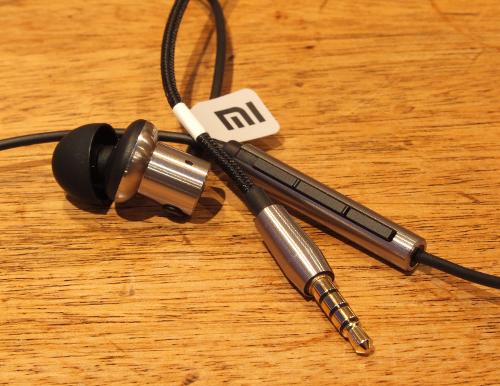
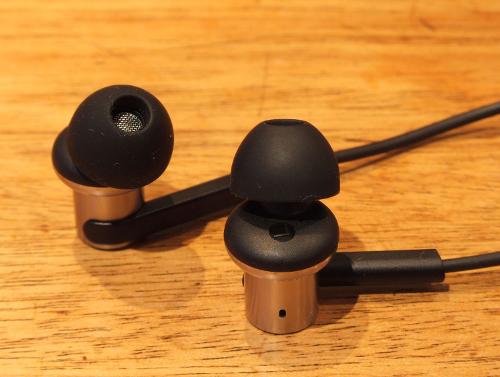
I straight away tried the Hybrids with my xDuoo X3, and I felt the sound was pretty good, though not remarkable – clear, open, pretty clean, and a decent sound-stage. I'm not entirely sure whether I'm a believer in burn-in or not – but I do tend to do it, and sometimes I thnk it makes a difference, so I plugged the Hybrids into a portable CD player, popped in a Daft Punk CD, turned the volume up to loud (but not blisteringly so) put it on repeat and let it get on with it for 24 hours or so. It gave me a chance to look at how well the phones are made in the meantime...
I've got to say it, I'm impressed with the build quality of these IEMs – the finish on mine was flawless. Impeccable lathe-cut finishing on the metal parts, perfect fit with the moulded plastic components and good quality cable, and nicely executed details like the HD Audio laser-etched into each earpiece. There are some nice little details, like the tiny "breather port" in the plastic tube moulding of each unit (just by the moulded "L" in the photo below) – I surmise that these function to help eliminate any pressure on the diaphragm of the driver (or your eardrum) when you insert the earphone into your ear canal – helping both to function as nature intended. For the shape of my ears, comfort is superb – day long listening is no problem. For what it's worth, the remote is fully compatible with my Nokia Lumia Windows (8.1) phone, and gives play/pause on the centre button and volume up/down on the upper and lower buttons. These don't feel like cheap IEMs - they feel like the real deal.
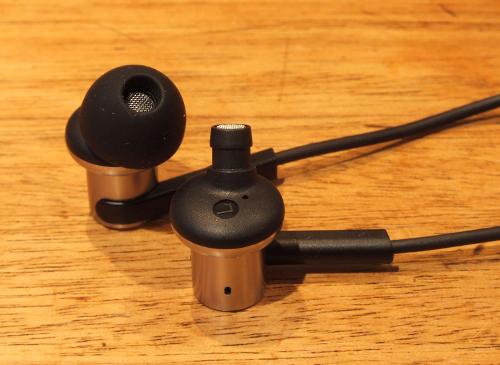

After a day of burn-in I listened again – and really listened... Mmm... What I got straight away was an incredibly relaxed presentation. Don't get me wrong – I don't mean sloppy or haphazard – I mean that it was open and unforced, and very un-fatiguing to listen to – even for extended periods. I would find myself listening for far longer (and later into the night) than I had planned to, because I was hearing subtle details in the music that I had missed before with my other IEMs. The relaxed presentation put me in mind of my full-sized (over ear) headphones, only with that greater sense of intimacy to the sound that IEMs can sometimes give.
Breaking this down and listening for a lot longer (over a number of weeks), I find that the Hybrids really can communicate a huge amount of information in a superbly coherent way. The soundstage (from a good source) is really convincing – you can hear the layout of an orchestra. Once when I was listening to Kate Bush's Hounds of Love album I suddenly turned round because it really felt like someone was right beside me talking into my ear – uncanny!
For me, the bass is well controlled and detailed. It's full and satisfying, but not overbearing. I have a specific test track (Glistening Fields from Iarla O'Lionaird's album Foxlight) which practically goes into sub-sub bass – these phones will reproduce that faithfully.
The treble is incredibly clean and well detailed – I was listening to Moby's album 18 only today and there's a track which has the sound of a damped cymbal being struck quite near the centre with a hard-tipped drumstick – and the Xiaomi Hybrids really picked that up – it sounded so real. I don't know if that's the balanced armature drivers doing their job, but it sounded great to me.
A number of people have commented that there is a mid-range hole with these phones, or that the sound signature is V-shaped. I don't really find that. For me, the mid-range is nicely present, clear and well detailed – speech and vocals are natural, and the mid integrates seamlessly with the treble. I think it's what also contributes to a good sound-stage – the degree of coherence in the whole sound spectrum.
Just the other day, I was wondering why some people find the mid-range on the hybrids rather recessed, and then I remembered that some people listen at rather higher volumes than I perfer to, so I tried turning up the volume with these earphones – and I noticed that at higher volumes, the bass does tend to dominate, and lose a bit of control – causing the mid-range to recede. Perhaps this was the cause? I don't know – it was way above a level that I'd want to listen to even for a short period, so a non-issue for me. However, if you like to listen at higher volume, these may not be for you.
I could go on for longer, but I'm not sure I'd convey much more useful information. The bottom line is that I'm seriously impressed with the Xiaomi Hybrids. For me, thay just get out of the way and allow me to really enjoy my music, and hear nuances and details that I'd not picked up before. No, they are surely not the best IEMs available, but at the price I paid I find them pretty compelling. I've ordered a second pair as a spare.
I'm 52 and live in the UK. I've been into audio since my teens. I built my first stereo amp when I was 16, and I know one end of a soldering iron from the other, and mostly I remember to pick it up at the end the lead comes out of... My last project was upgrading the capacitors and resistors in my Quad 33 pre-amp. I started playing the cello when I was about 8 or 9, gave it up when I was about 15, but missed the feel and sound of playing an instrument, and so bought and taught myself to play the mandolin when I was 18 and supposedly studying for my exams. Music has been a big part of my life for as long as I can remember. Playing an instrument helps remind me what real, live instruments can sound like, and what the experience of music is about.
My musical tastes are eclectic, from classical (Bach on period instruments, Tallis and Victoria renaissance choral, Vaughan Williams and Holst full orchestral) through all kinds of folk and rock (Dylan, Robert Plant, Nick Cave, Richard Hawley, Jackie Leven) and out the other end to dance and techno and wold-beats (Daft Punk, Orbital, Afro Celt Sound System). For me, good audio equipment is all about it getting out of the way and letting me listen to the music.
I first became aware of the Xiaomi Hybrid earphones from browsing around Gearbest's website looking for LED bicycle lights. They looked interesting: nice clean design appearance, and on paper a good set of specifications with a driver configuration I'd not listened to before, and then there was the bargain price – about (UK) £12 at the time. These earphones have hybrid drivers - a conventional, dynamic "voice coil" driver to handle lower frequencies, and a much smaller balanced armature driver to deal with upper mids and treble frequencies. Whether there is any electronic crossover circuitry to divide the frequencies between each unit, or it's achieved simply by the mechanical limitations of each driver I don't know, but hybrid drivers are normally pretty much unheard of at this price point. Definitely worth a punt.
My headphone listening varies: at home I have a couple of full-size rigs – Arcam and Cambridge Audio CD players driving a Schiit Magni, a Pro-ject Headbox S, a Mr Nixie Russian valve (tube) hybrid amp, and a Project Starlight valve hybrid amp. My full-size headphones are Sennheiser HD598 and Audio Technica ATH-M50x. However, I'll also listen to a Sony MZ-RH1 Hi-MD recorder and an xDuoo X3 DAP at home and at work using a range of IEMs including Musical Fidelity EB33, Sennheiser CX870. Most of my IEM listening is either at work (office) or late at night when the house is quiet.
After about 10 days, the Xiaomi Hybrid IEMs arrived. The packaging is a nice, plain and simple card carton with a tear-off seal and the phones held securely by a hard foam insert. There's a plastic bag with different sizes of silicone ear-tips, and a printed sheet of instructions (in Chinese). I tend to keep my IEMs in inexpensive hard EVA zip-up cases, so the minimal packaging suits me just fine.


I straight away tried the Hybrids with my xDuoo X3, and I felt the sound was pretty good, though not remarkable – clear, open, pretty clean, and a decent sound-stage. I'm not entirely sure whether I'm a believer in burn-in or not – but I do tend to do it, and sometimes I thnk it makes a difference, so I plugged the Hybrids into a portable CD player, popped in a Daft Punk CD, turned the volume up to loud (but not blisteringly so) put it on repeat and let it get on with it for 24 hours or so. It gave me a chance to look at how well the phones are made in the meantime...
I've got to say it, I'm impressed with the build quality of these IEMs – the finish on mine was flawless. Impeccable lathe-cut finishing on the metal parts, perfect fit with the moulded plastic components and good quality cable, and nicely executed details like the HD Audio laser-etched into each earpiece. There are some nice little details, like the tiny "breather port" in the plastic tube moulding of each unit (just by the moulded "L" in the photo below) – I surmise that these function to help eliminate any pressure on the diaphragm of the driver (or your eardrum) when you insert the earphone into your ear canal – helping both to function as nature intended. For the shape of my ears, comfort is superb – day long listening is no problem. For what it's worth, the remote is fully compatible with my Nokia Lumia Windows (8.1) phone, and gives play/pause on the centre button and volume up/down on the upper and lower buttons. These don't feel like cheap IEMs - they feel like the real deal.


After a day of burn-in I listened again – and really listened... Mmm... What I got straight away was an incredibly relaxed presentation. Don't get me wrong – I don't mean sloppy or haphazard – I mean that it was open and unforced, and very un-fatiguing to listen to – even for extended periods. I would find myself listening for far longer (and later into the night) than I had planned to, because I was hearing subtle details in the music that I had missed before with my other IEMs. The relaxed presentation put me in mind of my full-sized (over ear) headphones, only with that greater sense of intimacy to the sound that IEMs can sometimes give.
Breaking this down and listening for a lot longer (over a number of weeks), I find that the Hybrids really can communicate a huge amount of information in a superbly coherent way. The soundstage (from a good source) is really convincing – you can hear the layout of an orchestra. Once when I was listening to Kate Bush's Hounds of Love album I suddenly turned round because it really felt like someone was right beside me talking into my ear – uncanny!
For me, the bass is well controlled and detailed. It's full and satisfying, but not overbearing. I have a specific test track (Glistening Fields from Iarla O'Lionaird's album Foxlight) which practically goes into sub-sub bass – these phones will reproduce that faithfully.
The treble is incredibly clean and well detailed – I was listening to Moby's album 18 only today and there's a track which has the sound of a damped cymbal being struck quite near the centre with a hard-tipped drumstick – and the Xiaomi Hybrids really picked that up – it sounded so real. I don't know if that's the balanced armature drivers doing their job, but it sounded great to me.
A number of people have commented that there is a mid-range hole with these phones, or that the sound signature is V-shaped. I don't really find that. For me, the mid-range is nicely present, clear and well detailed – speech and vocals are natural, and the mid integrates seamlessly with the treble. I think it's what also contributes to a good sound-stage – the degree of coherence in the whole sound spectrum.
Just the other day, I was wondering why some people find the mid-range on the hybrids rather recessed, and then I remembered that some people listen at rather higher volumes than I perfer to, so I tried turning up the volume with these earphones – and I noticed that at higher volumes, the bass does tend to dominate, and lose a bit of control – causing the mid-range to recede. Perhaps this was the cause? I don't know – it was way above a level that I'd want to listen to even for a short period, so a non-issue for me. However, if you like to listen at higher volume, these may not be for you.
I could go on for longer, but I'm not sure I'd convey much more useful information. The bottom line is that I'm seriously impressed with the Xiaomi Hybrids. For me, thay just get out of the way and allow me to really enjoy my music, and hear nuances and details that I'd not picked up before. No, they are surely not the best IEMs available, but at the price I paid I find them pretty compelling. I've ordered a second pair as a spare.
MandoBear
I don't have an ipod shuffle, but I can't think of any reaon why they wouldn't work well.
Otto Motor
Very natural sound, but they lack punch and soundstage compared to much more expensive competition. Bass can lead into the vocals (lower mids). Great build: metal housing. And they fit my ears really well. Overall a great buy.
viperxp
100+ Head-Fier
Pros: Features for the price,fit,isolation
Cons: Not really HD
Greetings,
This review will be dedicated to a pair of interesting earphones from Xiaomi. As usual I will provide a small background, and get to the actual review later.
First , what does that "hybrid" mean, and why Xiami?
Well, there earphones feature two types of transducers - the usual dynamic, and balanced armature. In theory, this should provide better high frequency response. Prior to those earphones no other manufacturer offered balanced armature, or a hybrid design for less than 20$, so this is a game-changer in a way.
The earphones (like other Xiaomi headphones) are actually manufactured by 1MORE, and I will compare these earphones with another, much more expensive model from 1More.
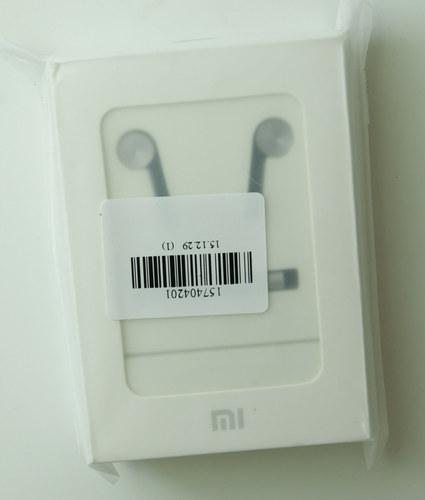

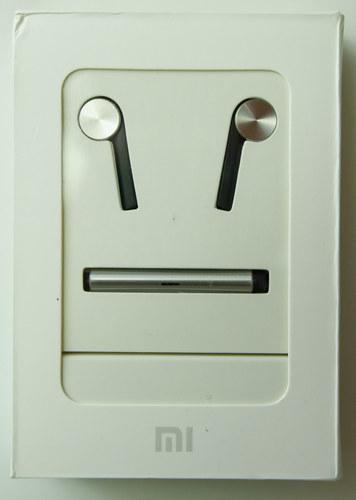


The earphones arrive in a very small carton white box. You can see the back side of the earphones and their technical specifications.

The box has some kind of seal, so you"ll be able to ensure that you are the first one to use them.


There is not much that comes with the earphones, only earphones and some additional eartips (average quality, slightly thin rubber is used).
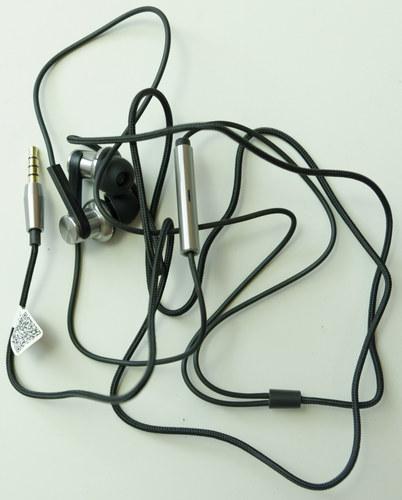
And.. here they are

The plug is gold-plated, and made mostly from metal.

The cable has black fabric coating, and feels pretty thin. Interestingly - it is very durable, I unintentionally tested it. While burning in the phones I rolled with a chair over and over the cable but it did not affect the sound quality, it held the misuse pretty well.

The remote control. It's made from metal, but the buttons are made of plastic. It controls android devices, but not IOS.

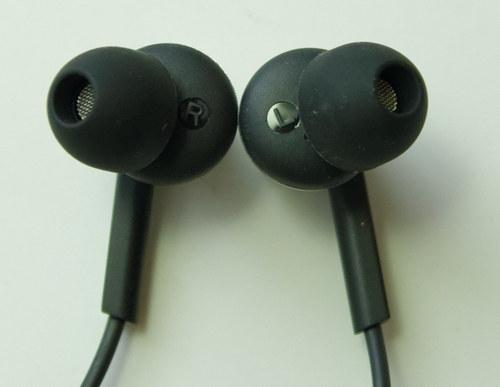


And.. here they are. Well, the earphones are mostly made of metal, but don't feel very massive or heavy.

There is small laser-engraved HD Audio writing, and you can also see the bass port on the side of the earphones.

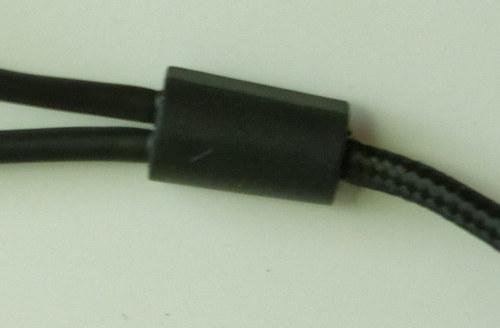
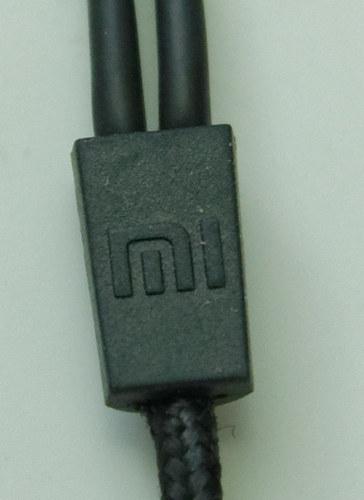
The Y-split is made of plastic and carries the XiaoMI logo.
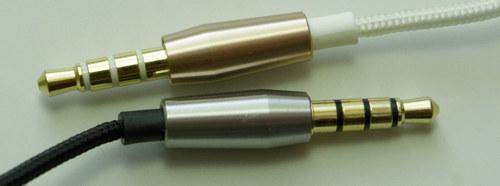
This is a comparison with 1More hybrid earphones
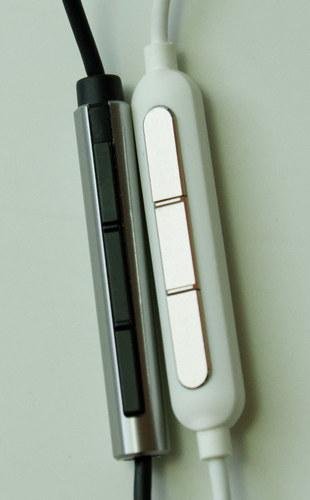
The remote on the 1More is plastic with metal buttons, opposite of Xiaomi's metal with plastic buttons remote.

The Y split is also very different, metal vs plastic.
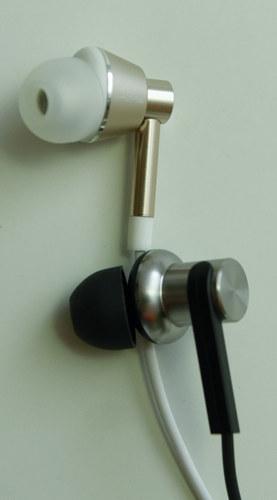

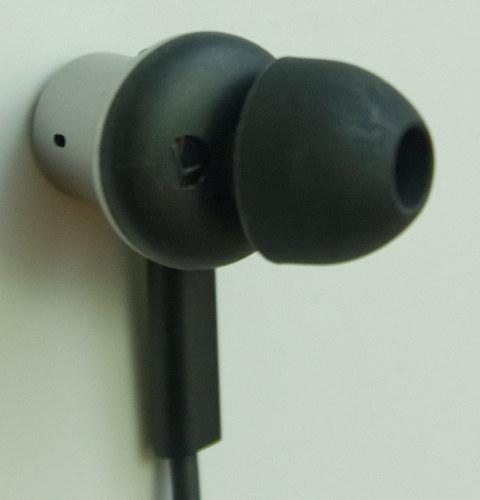
1More earphones look much more expensive, and are much bigger in size than the Xiaomi earphones.
Well, first of all the fit. Those are very comfortable earphones. I didn't feel the need to fit any other eartips that the ones that were initially installed. The earphones are being mounted very securely inside the ears, much better than Xiaomi Piston 2 or the 1More hybrids.
Sound isolation - it is great with these earphones, even without turning on the music most of the outside sounds are blocked.
The sound - well, it was not exactly what I expected. The sound can be described as U shaped, with a lot of bass, great highs and not much mids. Surprisingly, this is not necessary a bad thing - those earphones are very forgiving to the mastering quality, and provide a great soundstage. Certain music genres that have plenty of bass sound just fantastic with those phones. and even others, that have more accent on mid frequencies sound good, just not as you would expect them to sound.
The bass is deep and fast, I did not feel it affect other frequencies.
Mids - are recessed, but not colored. You hear what the recording has to offer, just not as loud as the bass and the highs that those earphones provide.
Highs - are great, clear, maybe even crystal clear. The mids quantity only put more accent on the excellent highs.
HD Audio - I don't think that the sound of those earphones could be the real HD Audio that you would have hoped to get, but they are really enjoyable, While testing the earphones, and afterwards I found myself reaching to those earphones more and more, just in order to enjoy the music - while I could hear other, more analytic earphones.
The audition was made using FiiO X3 II DAP and lots of lossless music.
Those are nice earphones. I don't know if they really have competition in the sub 20 dollars segment and will be a great ticket to BA earphones. While the sound can hardly be described as audiophile or analytic, the earphones are very easy to enjoy, and provide a surprising sense of width to the recordings. The earphones are very well made, and have a very strong cable.
The earphones were provided for review by www.gearbest.com
This review will be dedicated to a pair of interesting earphones from Xiaomi. As usual I will provide a small background, and get to the actual review later.
First , what does that "hybrid" mean, and why Xiami?
Well, there earphones feature two types of transducers - the usual dynamic, and balanced armature. In theory, this should provide better high frequency response. Prior to those earphones no other manufacturer offered balanced armature, or a hybrid design for less than 20$, so this is a game-changer in a way.
The earphones (like other Xiaomi headphones) are actually manufactured by 1MORE, and I will compare these earphones with another, much more expensive model from 1More.
Part 1 - design and physical impressions





The earphones arrive in a very small carton white box. You can see the back side of the earphones and their technical specifications.

The box has some kind of seal, so you"ll be able to ensure that you are the first one to use them.


There is not much that comes with the earphones, only earphones and some additional eartips (average quality, slightly thin rubber is used).

And.. here they are

The plug is gold-plated, and made mostly from metal.

The cable has black fabric coating, and feels pretty thin. Interestingly - it is very durable, I unintentionally tested it. While burning in the phones I rolled with a chair over and over the cable but it did not affect the sound quality, it held the misuse pretty well.

The remote control. It's made from metal, but the buttons are made of plastic. It controls android devices, but not IOS.




And.. here they are. Well, the earphones are mostly made of metal, but don't feel very massive or heavy.

There is small laser-engraved HD Audio writing, and you can also see the bass port on the side of the earphones.



The Y-split is made of plastic and carries the XiaoMI logo.

This is a comparison with 1More hybrid earphones

The remote on the 1More is plastic with metal buttons, opposite of Xiaomi's metal with plastic buttons remote.

The Y split is also very different, metal vs plastic.



1More earphones look much more expensive, and are much bigger in size than the Xiaomi earphones.
Part 2 - Real life usage and sound
Well, first of all the fit. Those are very comfortable earphones. I didn't feel the need to fit any other eartips that the ones that were initially installed. The earphones are being mounted very securely inside the ears, much better than Xiaomi Piston 2 or the 1More hybrids.
Sound isolation - it is great with these earphones, even without turning on the music most of the outside sounds are blocked.
The sound - well, it was not exactly what I expected. The sound can be described as U shaped, with a lot of bass, great highs and not much mids. Surprisingly, this is not necessary a bad thing - those earphones are very forgiving to the mastering quality, and provide a great soundstage. Certain music genres that have plenty of bass sound just fantastic with those phones. and even others, that have more accent on mid frequencies sound good, just not as you would expect them to sound.
The bass is deep and fast, I did not feel it affect other frequencies.
Mids - are recessed, but not colored. You hear what the recording has to offer, just not as loud as the bass and the highs that those earphones provide.
Highs - are great, clear, maybe even crystal clear. The mids quantity only put more accent on the excellent highs.
HD Audio - I don't think that the sound of those earphones could be the real HD Audio that you would have hoped to get, but they are really enjoyable, While testing the earphones, and afterwards I found myself reaching to those earphones more and more, just in order to enjoy the music - while I could hear other, more analytic earphones.
The audition was made using FiiO X3 II DAP and lots of lossless music.
Final thoughts, conclusion
Those are nice earphones. I don't know if they really have competition in the sub 20 dollars segment and will be a great ticket to BA earphones. While the sound can hardly be described as audiophile or analytic, the earphones are very easy to enjoy, and provide a surprising sense of width to the recordings. The earphones are very well made, and have a very strong cable.
The earphones were provided for review by www.gearbest.com
thatBeatsguy
Headphoneus Supremus
Pros: Breaks the limits of hybrid earphone prices.
Cons: The two drivers don't really sound all that good.
Intro
Before I begin, I would like to sincerely thank George at Gearbest.com for providing the Xiaomi Hybrid you see in this review in exchange for my honest opinion. Please note that I am neither affiliated with Gearbest or any of its staff, nor am I being paid to write this review. All opinions expressed in this review are my own unless otherwise specified, and all photos in this review were taken by me. Finally, please take my following opinions with a grain of salt. Thanks!Not long after the release of the Pistons 3.0, everyone on the Pistons threads – myself included – was surprised to hear news about a new IEM from Xiaomi. Immediately the “first responders” set up shop and gathered scraps of info quickly, and this new IEM was dubbed the Pistons 4.0 – at least, until the translations came out. No, this is a brand-spanking new IEM from the smartphone manufacturer featuring a hybrid dual driver design at the same price the entire Pistons line was sold at -- $16, or CNY 99. That, in and of itself, is a crazy – and risky – feat to pull off.
The question is – did Xiaomi pull it off right? Find out after the jump.
(Note: I wasn't able to upload my photos of the Hybrid due to slow Internet speed. You can check out the pictures here, or alternatively look at other photos from other reviewers.)
== Aesthetics ==
Packaging, Accessories

Selling a dual-driver design at a $20 price point is outright insane. At that point, profit margins are already so low you probably won’t notice there’s even any profit from this. Trying to sell one with the same stuff the Pistons 3.0 had and still making a noticeable profit, however, is outright impossible –even Xiaomi seems to acknowledge that. As such, they had to make compromises. And what other place would be so easy to cut costs on than the packaging?
To summarise, Xiaomi eschewed the fancy plastic case and neat silicone earphone holder of the Pistons line in favour of a package made almost entirely out of cardboard. As much of a disappointment as it is, it really isn’t that much of a big deal unless you have a pressing need to store the Hybrids when not in use. Even then, the cardboard “case” of the Hybrids seem to do an equally effective job (at least until the cardboard is crushed at some point). If the Hybrids are your first serious IEM purchase, you’d probably be using them as your main IEM, so again, the lack of a proper case isn’t that big of a deal.

(As a side note, believe it or not, the Hybrid can fit in the Pistons 3.0’s silicone case. We’ll cover why in a bit.)
Design, Build, Microphonics

Design-wise the Xiaomi Hybrid is actually quite similar to the Pistons 3.0 released before it. Their new housings and Y-split aside, the two IEMs share the same remote/mic unit, the same angled nozzles, the same cable, and the same straight connector. The only difference between the aforementioned parts is a colour change, as you can see in the image to the right. These design similarities allow Xiaomi to reduce manufacturing costs by using the same parts from an earlier design, and also allow the Hybrid to fit in the 3.0’s silicone case as I mentioned earlier.
On that note, the similarities between the two Xiaomi IEMs in design also translate to similarities in build. As such, I don’t think one would be disappointed in the build of the Hybrids here – they’re about as durable as one could expect of a $20 IEM. The cable still has that Kevlar (or whatever fabric it is) below the Y-split, so expect cable noise similar to the Pistons 3. However, considering the fact that the Hybrid takes from most of the components of the 3.0, I’m a little confused as to why they decided to make an entirely new Y-split in its place – it’s really little more than a tiny, flimsy rubber square (in comparison to the metal-housed Y-split of the Pistons 3.0). In the end, though, it’s still the end user that determines how long an IEM lasts. Care for it well and it should last.
Fit, Comfort, Isolation
The Hybrid, again having taken from its predecessor’s design, also has similar fit characteristics to the Pistons 3.0. The fit is similarly straightforward, and also quite comfortable. They are mainly worn straight-down, so cable noise might be an issue, but you can wear them around the ear with a little practice (same goes for the Pistons 3.0). The Hybrid doesn’t seem to employ the dual damping system for the Pistons 2.0 and 3.0, so less airflow is permitted through the housing and, as such, better passive isolation compared to the aforementioned IEMs.== Sound ==
Specs
| Headphone Type | Closed-back in-ear monitor |
| Driver Type | 1x dynamic, 1x balanced armature |
| Frequency Response | 20 – 20,000 Hz |
| Rated Input Power | 5 mW |
| Sensitivity | 101 dB |
| Impedance | 32 Ω |
| Weight | N/A |
| Cable | 1.25m (~4’) Kevlar-reinforced cable |
| Connector | 3.5mm (1/8”) straight TRRS connector |
| Accessories | 4x sets silicone eartips (XS/S/M/L) |
Equipment, Burn-in
The source equipment used in this review is a fifth-generation iPod Touch and an iPad 3 directly running the Xiaomi Hybrid, and a PC running iTunes 12 and Foobar2k powering the Jive through a Schiit Fulla DAC/Amp. The EQ apps used in their respective test is TuneShell on iOS and Electri-Q on the PC. The eartips used on the Hybrid are the included medium size eartips. The list of the test tracks I listen to while reviewing the Jive can be found here, although I will include links to specific songs in the review for a more direct point of reference.The Hybrids have been burned-in for at least 50 hours prior to this review, most of which comprised of direct listening sessions. Over that period I noted some changes, which I will explain in further detail below.
With everything else said and done, let’s get to the sound.
Sound Quality
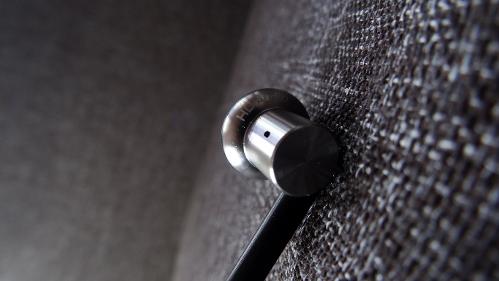
Bass:
The Hybrid’s dynamic driver starts off strong with an impactful low-end reminiscent of the Pistons 2.0, but with control more akin to that of the 3.0. Its more restricted venting system allows for better passive isolation, allowing you to hear its great sub-bass extension (Wiz Khalifa – On My Level). Its strength also contributes to the Hybrid’s warm midrange tonality, giving lower octaves a heavier, more viscous response. Similar to the 2.0, I found the Hybrid’s bass to be a little overbearing and excessively thick at times (Coldplay – Magic), but it’s not the worst I’ve ever heard (although from an “audiophile” standpoint, it does come quite close).
Midrange:
What really piqued my interest in the Hybrid was how the drivers would handle the midrange and treble. But to be honest, when I listened to them straight out of the box, I was not impressed. For me, they just didn’t have the presence that allowed it to shine through any genre of music as the 3.0 was capable of. I mean, sure, they don’t sound particularly bad, but there was just something…missing in the vocals and the instruments in the music that I wasn’t able to put my finger on at first.
Treble:
But then it hit me. The Hybrids weren’t off in the midrange; they were off in the treble. To sum things up without wasting too much time, the treble frequencies of the Xiaomi Hybrid were tuned to have as little sibilance as possible. No, really, they have practically no sibilance from what I’m hearing. Though having little sibilance is a good thing, there is what they call too much of a good thing. This is what they call too much of a good thing.
I have read other impressions of the Hybrids from other owners of the IEM on the primary Head-Fi thread, and a few of them seem to report not much “detail” on these Hybrids. To be honest, this intrigues me a bit, as in my opinion treble “quantity” doesn’t outright mean treble “detail”. Okay, yes, it doesn’t have that much treble detail as far as I can hear, but once I put it up against the other Xiaomi earphones I found they all have similar levels of detail retrieval, or at least, as my ears tell me.
In the end, though, the treble dip in the sibilance region still confuses me. This never existed in the old Pistons line, which leads me to think something – or someone – made a suggestion to the tuning that made the Hybrid sound the way it does. Could it be that Luca Bignardi dude that Xiaomi was said to hire according to their official page? All signs seem to point to him. Whoever he is, I think he’s made it clear to himself and to the entire audiophile community that he does not know how to tune a headphone (well, either that or he just has a weird way of hearing things.
Soundstage/Presentation:
Being a more closed-back IEM compared to the rest of Xiaomi’s manufactured earphones, their soundstage sounds more compressed and restricted in comparison to the airier presentation of, say, the Pistons 2 and 3. Their spatial imaging is decent, but nothing here stands out.
Genre Proficiency:
The overall signature of the Hybrid leans towards a rather dark, bass-heavy sound signature. It doesn’t offer anything special midrange-wise, so you won’t find them to do much justice to acoustic recordings (Yiruma – Indigo, Coeur de Pirate – Off to Sleep). They are, however, clear enough to make electronic genres sound pretty good (Televisor – Deya, 7 Minutes Dead – Sidewinder).
Summary:
Overall the Xiaomi Hybrid does not impress me sound-wise. I mean, the Hybrids have pretty controlled bass and a decently clear midrange, but their unusual treble tuning has vocals sounding rather off in my opinion. I know I don’t have any experience with hybrid earphones as of this writing, but I don’t think the Hybrids sound like hybrids – in fact, I think the guys behind the IEM could’ve just left it a single dynamic and it’d probably sound just as good (or as bad, whichever opinion you have). I just don’t think they bring any more to the table than the Pistons 2.0 and 3.0 already do.
Other Media
My conclusion in this section is the same as that of the main Sound Quality section – the Xiaomi Hybrids sound decent, but nothing about them makes me really want to listen more. For gaming, their rather dark-tilted signature doesn’t really prove helpful. However, I did like how the Hybrids played along with movies. The bass is explosive enough to match that of a half-decent cinema, and all in all it really isn’t all that bad, so a bit of a “meh” here for me.EQ & Amp Response
Being an IEM with a 101 dB sensitivity figure, it’s clear they’re designed to work with weaker-powered devices – such as mobile devices – without any fuss. On that note, they don’t seem to improve much with amplification – at least, when I give them the extra power output from my Schiit Fulla. EQ, however, seems to work quite effectively on the Hybrids. With a little tweaking, one can manage to compensate for the treble dip in the Hybrids and bring back the upper registers it’s supposed to have. With that they actually start to sound more like the Pistons follow-up we’ve all been waiting for. But considering the fact that this is after compensation, it’s still a little disappointing to say the least.Value
The Xiaomi Hybrids retail for $16 dollars, or 99 CNY – the same price the Pistons 2 and 3 before it retailed for. Now, that’s not a bad price per se – but when you consider its price bracket, now oversaturated and overrun by “hype of the year” and “flavour of the month” IEMs, you really can’t consider the Hybrids to have that high of a price-to-performance ratio. And what really made the Pistons 2 and 3 the budget hits they were – their secret to success – was just that – their insane value for the money. At the low, low price of $16 dollars, you could get an accommodating IEM that does what it needs to and doesn’t leave you hanging (unless you’re a veteran audiophile or just picky). At that same price, you can also get one of the hype-of-the-year brand-less Chinese IEMs that provide high performance, but at the cost of severe reliability issues.Comparison
Versus Xiaomi Pistons 3.0 ($16):The Pistons 3.0 is, by far, one of my favourite IEMs; there’s no doubt about that. There’s also no doubt that it completely defeats the Hybrid in all aspects. Build-wise the Hybrid is worrying in certain aspects. Sound-wise they really just can’t keep up. To be honest, I’m a little dismayed. I mean, considering the fact that the Hybrids have two drivers at their disposal, you’d expect them to sound phenomenal.
Versus Xiaomi Pistons 2.0 ($16):
Early impressions from other reviewers pointed to the hybrids being a sort of sound-wise “middle ground” between the more balanced 3.0 and the bass-heavy 2.0. But now that I have the Hybrids for myself I can’t bring myself to say that anymore. These Hybrids are an entirely different monster…and not in a good way. The treble dip still bothers my ears to no end, and the bass, though fine, doesn’t really help in the IEM’s overall sound. The Pistons 2.0, at least, sounds much more coherent and natural (if you can call it that).
== Conclusion ==

In the end, I can’t bring myself to recommend the Xiaomi Hybrid to anyone. They just don’t provide the level of performance you’d expect from a hybrid follow-up to the great-sounding Pistons 3.0, instead sounding more like an experimental prototype than anything. I will admit, though, it is a respectable effort by Xiaomi to break the price limits and provide a hybrid IEM design at a sub-$20 price point – and that is insane. But even then, it still just doesn’t sound that good.
| Category | Score | Comment |
| Packaging, Accessories | 6.5/10 | Same accessories as in the Pistons 3.0, but the all-cardboard packaging is a little disappointing compared to the old fancy plastic case. |
| Design, Build, Microphonics | 7/10 | Build is pretty average for a Xiaomi IEM, with the Hybrid taking most of its components from its predecessor. The Y-split is a little worrying, however. |
| Fit, Comfort, Isolation | 7.5/10 | The Hybrid employs a closed-back design, which offers better isolation compared to the Pistons line. Its fit, however, is similar to the Pistons 3.0, which may or may not be a good thing. |
| Bass | 7/10 | Solid and impactful, it aims to please the consumer listener, but it’s not exactly “great” by any “audiophile” standards. |
| Midrange | 7/10 | Its midrange is actually quite clear for what it is, but a treble dip in the tuning makes a lot of instruments sound off. |
| Treble | 5/10 | The treble is the game changer in the Xiaomi Hybrid – but not the good kind. |
| Presentation | 6.5/10 | Pretty good across the board, but don’t expect anything better than the other Xiaomi earphones. |
| Gaming, Movies | 6.5/10 | See above. |
| EQ Response | 7/10 | They sounded pretty darn good after applying frequency compensation. |
| Value | 6/10 | See below. |
| Total | 6.6/10 | Overall I really can’t recommend the Xiaomi Hybrid, what with their underwhelming sound quality that doesn’t live up to the performance of its predecessors. |
Suggestions for Improvement
Improve the tuning.Kick out the one responsible for the treble dip.
Shout-Outs, Gallery
Again I would like to sincerely thank George at Gearbest.com for providing the sample unit of the Xiaomi Hybrid you see in this review. You could check out the rest of the images I took during the shoot here (link unavailable), and you could check out some more of my reviews here.This has been thatBeatsguy of DB Headphones; thanks for reading!
Changelog
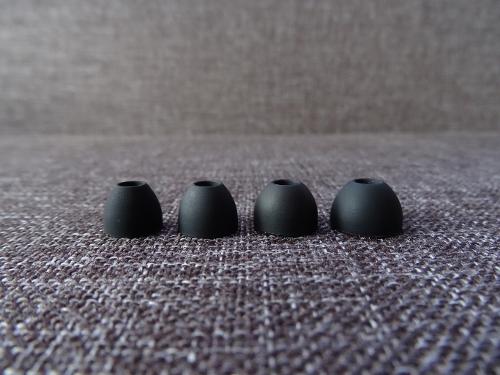


Wembely
Thanks for the review. I feel the same way - they just flat out miss the mark. I had such high expectations and in the end just feel let down by what could have been... Maybe they will get it right on the next try


If anyone can tell me that if these mi hybrid in ear headphones pro supports ipod shuffle 4th gen? It doesnt matter that buttons should work or not. But sound should be perfect.